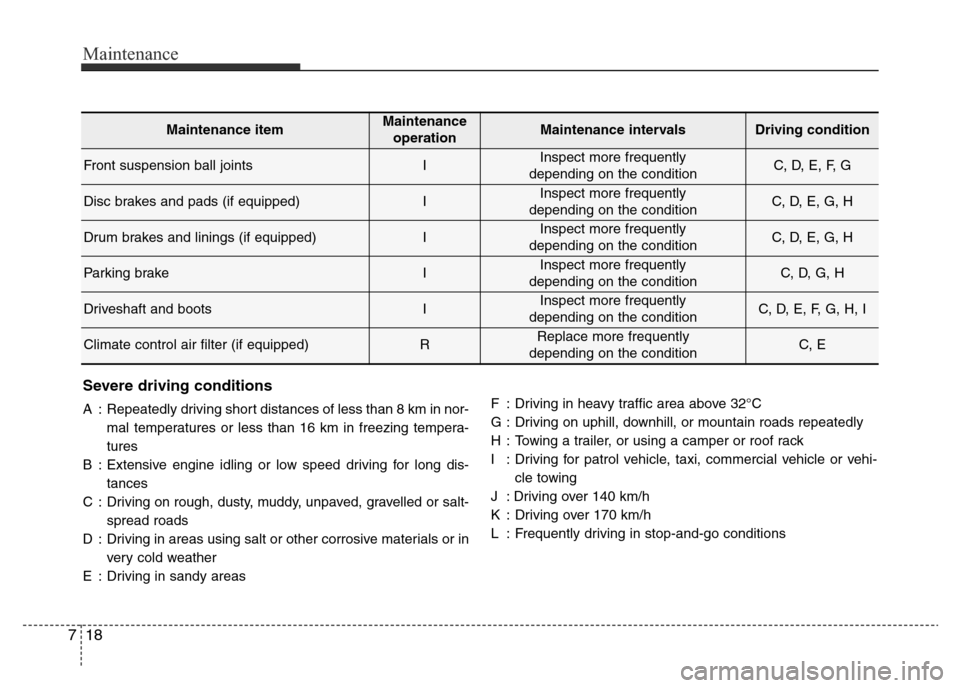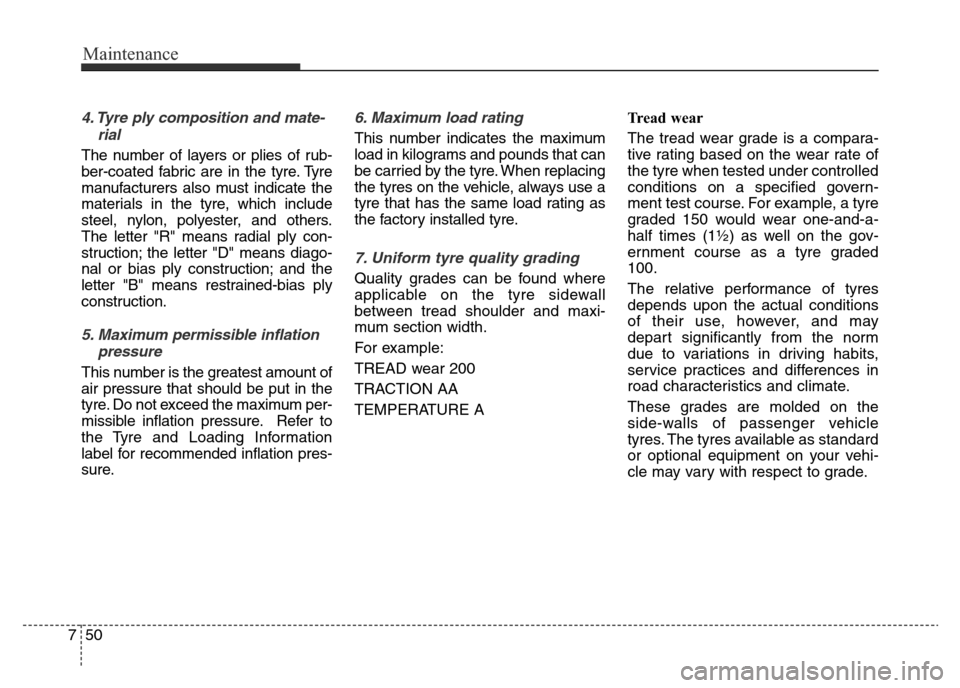Page 411 of 498
Maintenance
16 7
NORMAL MAINTENANCE SCHEDULE (CONT.)
(Continued)
❑ Inspect tyre (pressure & tread wear)
❑ Inspect manual transaxle fluid (if equipped) *8
❑ Inspect vapour hose and fuel filler cap
❑ Inspect vacuum hose
❑ Inspect cooling system
(At first, 60,000 km or 48months
after that, every 30,000 km or 24months)
❑ Replace climate control air filter (if equipped)
❑ Replace engine oil and filter *2
❑ Replace fuel filter *3
❑ Replace fuel tank air filter
❑ Replace spark plugs (Every 160,000 km)
❑ Replace coolant *5 *6
(At first, 210,000 km or 120months
after that, every 30,000 km or 24months)
No check, No service required
❑Automatic transaxle fluid (if equipped)
❈Inspect : Inspect and if necessary, adjust, correct, clean or
replace.
Page 413 of 498

Maintenance
18 7
Maintenance itemMaintenance
operationMaintenance intervalsDriving condition
Front suspension ball jointsIInspect more frequently
depending on the conditionC, D, E, F, G
Disc brakes and pads (if equipped)IInspect more frequently
depending on the conditionC, D, E, G, H
Drum brakes and linings (if equipped)IInspect more frequently
depending on the conditionC, D, E, G, H
Parking brakeIInspect more frequently
depending on the conditionC, D, G, H
Driveshaft and bootsIInspect more frequently
depending on the conditionC, D, E, F, G, H, I
Climate control air filter (if equipped)RReplace more frequently
depending on the conditionC, E
Severe driving conditions
A : Repeatedly driving short distances of less than 8 km in nor-
mal temperatures or less than 16 km in freezing tempera-
tures
B : Extensive engine idling or low speed driving for long dis-
tances
C : Driving on rough, dusty, muddy, unpaved, gravelled or salt-
spread roads
D : Driving in areas using salt or other corrosive materials or in
very cold weather
E : Driving in sandy areasF : Driving in heavy traffic area above 32°C
G : Driving on uphill, downhill, or mountain roads repeatedly
H : Towing a trailer, or using a camper or roof rack
I : Driving for patrol vehicle, taxi, commercial vehicle or vehi-
cle towing
J : Driving over 140 km/h
K : Driving over 170 km/h
L : Frequently driving in stop-and-go conditions
Page 427 of 498
Maintenance
32 7
CLIMATE CONTROL AIR FILTER (IF EQUIPPED)
Filter inspection
If the vehicle is operated in severely
air-polluted cities or on dusty rough
roads for a long period, it should be
inspected more frequently and
replaced earlier. When you, the
owner, replace the climate control air
filter, replace it performing the follow-
ing procedure, and be careful to
avoid damaging other components.
Replace the filter according to the
maintenance schedule.
Filter replacement
1. Open the glove box.2. Remove the stoppers by turning
them anticlockwise on both sides.
OMD070013/H
OMD040129/H
Page 428 of 498
733
Maintenance
3. Remove the climate control air fil-
ter cover whilst pressing the lock
on both sides of the cover.4. Replace the climate control air filter.
5. Reassemble in the reverse order
of disassembly.
✽NOTICE
Install a new climate control air fil-
ter in the correct direction with the
arrow symbol (
↓) facing downwards.
Otherwise, the climate control
effects may decrease, possibly with a
noise.
OMD071015ROHG075041
Page 435 of 498
Maintenance
40 7
Reset items
Items should be reset after the bat-
tery has been discharged or the bat-
tery has been disconnected.
• Auto up/down window (See sec-
tion 4)
• Sunroof (See section 4)
• Trip computer (See section 4)
• Climate control system
(See section 4)
• Clock (See section 4)
• Audio (See section 4)WARNING
• Before performing mainte-
nance or recharging the bat-
tery, turn off all accessories
and stop the engine.
• The negative battery cable
must be removed first and
installed last when the battery
is disconnected.
Page 445 of 498

Maintenance
50 7
4. Tyre ply composition and mate-
rial
The number of layers or plies of rub-
ber-coated fabric are in the tyre. Tyre
manufacturers also must indicate the
materials in the tyre, which include
steel, nylon, polyester, and others.
The letter "R" means radial ply con-
struction; the letter "D" means diago-
nal or bias ply construction; and the
letter "B" means restrained-bias ply
construction.
5. Maximum permissible inflation
pressure
This number is the greatest amount of
air pressure that should be put in the
tyre. Do not exceed the maximum per-
missible inflation pressure. Refer to
the Tyre and Loading Information
label for recommended inflation pres-
sure.
6. Maximum load rating
This number indicates the maximum
load in kilograms and pounds that can
be carried by the tyre. When replacing
the tyres on the vehicle, always use a
tyre that has the same load rating as
the factory installed tyre.
7. Uniform tyre quality grading
Quality grades can be found where
applicable on the tyre sidewall
between tread shoulder and maxi-
mum section width.
For example:
TREAD wear 200
TRACTION AA
TEMPERATURE ATread wear
The tread wear grade is a compara-
tive rating based on the wear rate of
the tyre when tested under controlled
conditions on a specified govern-
ment test course. For example, a tyre
graded 150 would wear one-and-a-
half times (1½) as well on the gov-
ernment course as a tyre graded
100.
The relative performance of tyres
depends upon the actual conditions
of their use, however, and may
depart significantly from the norm
due to variations in driving habits,
service practices and differences in
road characteristics and climate.
These grades are molded on the
side-walls of passenger vehicle
tyres. The tyres available as standard
or optional equipment on your vehi-
cle may vary with respect to grade.